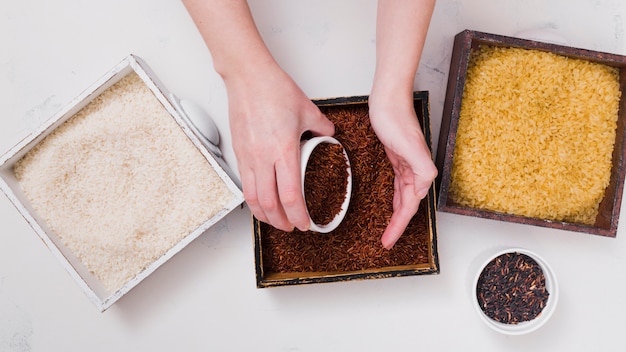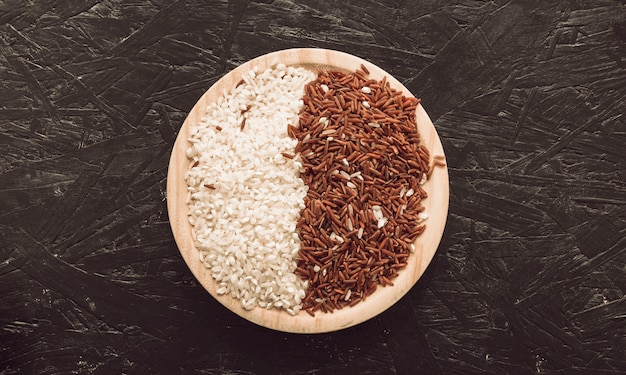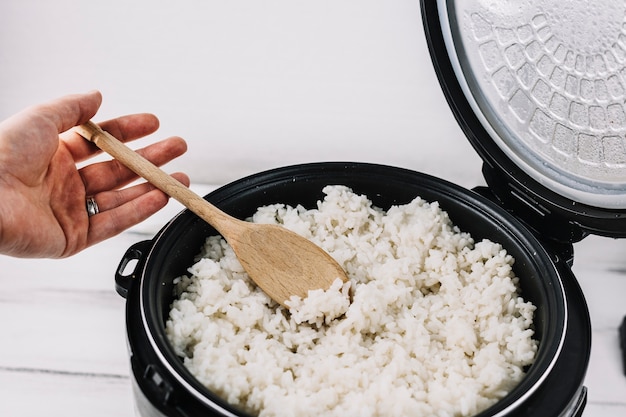Let's talk about brown rice, shall we? It's a kitchen staple for good reason, but getting it right can sometimes feel like a bit of a challenge. There's the rinsing, the soaking, the timing… it all adds up. But when you nail it, you're rewarded with a perfectly fluffy bowl of goodness. Brown rice is incredibly versatile too, and it's a healthy alternative to white rice. It can be used in so many ways, from salads and stir-fries to hearty soups and even desserts.
This guide is your cheat sheet to mastering brown rice, whether you're a seasoned cook or just starting out. We'll dive into everything from choosing the right type of rice to different cooking methods, plus all the tips and tricks I’ve picked up over the years. So, grab your favourite pan, get your ingredients ready, and let's get cooking!
(Part 1) Choosing the Right Brown Rice

First things first, you need to choose the right type of brown rice. There's a whole world of brown rice out there, each with its own unique flavour and texture. It's a bit like choosing a wine, really. You wouldn't grab a Sauvignon Blanc for a hearty stew, would you?
types of brown rice
- long grain brown rice: This is the most common type, and it’s what I usually use. It’s got a nice firm texture and a slightly nutty flavour, making it a great all-rounder for dishes like stir-fries and salads.
- medium grain brown rice: This one’s a bit chewier than long grain and has a slightly sweeter flavour. It holds its shape well, making it perfect for sushi or pilaf. It’s a bit more delicate than long grain, so it’s not ideal for hearty dishes.
- short grain brown rice: This rice is sticky and plump, similar to white sticky rice. It’s great for rice pudding or mochi, where you want that sticky texture to bind the dish together.
- black rice: This rice is a bit of a special treat! It has a deep, nutty flavour and a slightly chewy texture. It’s beautiful on its own, but it also makes a stunning garnish, adding a touch of visual interest and a pop of flavour to your dishes.
- red rice: Another beauty! It has a slightly chewy texture and a nutty flavour. It can be a bit more expensive than other types, but it’s definitely worth trying. It’s great for adding a bit of colour and texture to salads or as a base for bowls.
- wild rice: This one's not actually rice at all, but it's often grouped with rice because of its similar uses. It has a chewy texture and a slightly earthy flavour. It’s delicious mixed with other types of rice or used as a topping for soups and salads. It’s definitely a more unique flavour profile and adds a bit of rustic charm to your dishes.
My Favourite Brown Rice
Now, I'm a bit of a traditionalist when it comes to brown rice. I love the classic long grain variety for its versatility. It's the type I use for most of my cooking, whether it’s a simple side dish or a more elaborate dish. However, I do enjoy experimenting with other types, like black rice for a bit of a change-up. It adds a bit of drama to the plate and the flavour is fantastic.
Ultimately, the best brown rice for you depends on your personal preferences. Try a few different types and see what you like best!
(Part 2) Storing Brown Rice

Okay, so you’ve chosen your perfect rice. Now, let’s talk about storage. It's a simple step but crucial for keeping your rice fresh and delicious.
Storage Tips
- Airtight Container: This is a must! Keep your rice in an airtight container to prevent moisture and bugs from getting in. I always transfer my rice from the bag to a glass container. Glass is a great choice because it’s non-porous and doesn’t absorb flavours.
- Cool, Dark Place: Avoid storing your rice in direct sunlight or near heat sources. A cool, dark cupboard is ideal.
- Keep it Dry: Moisture is the enemy of rice. Make sure your container is dry before you put your rice in, and always keep it in a cool, dry place.
- Check the Expiration Date: Like everything else, brown rice has a shelf life. Make sure to check the expiration date on your packaging and use your rice within that timeframe. Even though it can last for a while, using it within the suggested timeframe ensures the best flavour and texture.
Just remember, proper storage is key to ensuring your rice stays fresh and tasty.
(Part 3) Prepping Your Brown Rice: A Matter of Preference

Alright, now we’re getting to the fun part! Preparing your brown rice is a crucial step for getting that perfect fluffy texture.
Rinsing and Soaking: A Debate
There's a bit of a debate about rinsing and soaking brown rice. Some people swear by it, while others think it's unnecessary. My take? It's a personal preference, but I find that rinsing and soaking helps to reduce the cooking time and create a fluffier texture.
My Approach to Prepping
I usually give my brown rice a good rinse under cold water until the water runs clear. This helps to remove any excess starch and dust. Then, I soak it in fresh cold water for about 30 minutes. This helps to soften the rice and makes it easier to cook.
Here's a quick breakdown of the process:
Steps to Prep
- Rinse the Rice: Pour your rice into a fine-mesh sieve and hold it under cold running water. Swirl the rice around gently to remove any excess starch and dust. Continue rinsing until the water runs clear. It’s like washing your rice in a gentle shower!
- Soak the Rice: Place the rinsed rice in a bowl and cover it with cold water. Allow it to soak for 30 minutes. This gives the rice a head start on the cooking process.
- Drain the Rice: After soaking, drain the rice thoroughly. You can do this by pouring the rice into a sieve or by gently tipping the bowl and letting the water run out.
Whether you choose to rinse and soak is up to you. Experiment and find what works best for your taste!
(Part 4) Cooking Brown Rice: The Ultimate Guide
Finally, we’re at the cooking stage! This is where your brown rice transforms into a delicious side dish or the base for your favourite meals.
Methods of Cooking Brown Rice
- Stovetop: This is the classic way to cook brown rice, and it’s also the simplest. All you need is a pot, water, and your rice. It’s a tried-and-true method that works well for most types of brown rice.
- rice cooker: If you’ve got a rice cooker, it’s a total game-changer! You just chuck your rice in, add water, and press a button. So easy! Rice cookers are great for consistent results and minimal effort.
- Oven: You can also bake brown rice, which creates a lovely crispy texture. It’s a bit more hands-off than stovetop cooking, but it’s a great option if you’re busy. It’s also a great way to cook brown rice in bulk.
Stovetop Method: A Step-by-Step Guide
Let’s break down the stovetop method in detail, as it’s the most versatile and accessible method.
Steps for Stovetop Cooking
- Combine Rice and Water: In a medium saucepan, combine 1 cup of brown rice with 2 cups of water. This is the standard ratio for most types of brown rice. You can adjust the amount of water slightly depending on the type of rice you are using.
- Bring to a Boil: Bring the mixture to a boil over medium-high heat, uncovered. You’ll know it’s boiling when the water is bubbling vigorously and steam is rising from the pot.
- Reduce Heat and Simmer: Once it starts to boil, reduce the heat to low and cover the pot. Simmer for 30-40 minutes, or until the rice is tender and has absorbed all the water. The rice should be cooked through and have a slightly firm texture. You can test it by biting into a grain.
- Fluff the Rice: Once the rice is cooked, remove it from the heat and let it sit, covered, for 5 minutes. Then, use a fork to fluff the rice and separate the grains. This helps to release any excess moisture and create a fluffier texture.
It’s pretty straightforward, right?
Important Tips for Stovetop Cooking
- Don't Stir: Once the rice is boiling, resist the urge to stir. Stirring will break up the rice and make it mushy. Let the rice cook undisturbed for the best results.
- Adjust Cooking Time: Cooking times can vary depending on the type of brown rice you're using, so it's always a good idea to check the package instructions. Some types of rice might take a little longer to cook, while others might cook faster.
- Taste Test: Before you serve the rice, taste a grain to make sure it's cooked to your liking. If it's still a bit crunchy, simmer for a few more minutes. It’s better to err on the side of undercooking than overcooking, as you can always add a little more cooking time.
(Part 5) Making Brown Rice Even Better
Right, so you’ve got perfectly cooked brown rice. But what if you want to take it to the next level?
Tips for Enhancing the Flavour
- Add Salt: A pinch of salt during cooking enhances the flavour of the rice. Salt is a magic ingredient that really brings out the flavour of the rice.
- Experiment with Herbs and Spices: Add a bay leaf, a sprig of rosemary, or a pinch of cumin to the cooking water for a flavour boost. Experiment with different combinations to find your favourites.
- Use Broth: For even more flavour, use vegetable broth or chicken broth instead of water. Broth adds depth and complexity to the rice and makes it even more flavourful.
- Add a Squeeze of Lemon: A touch of lemon juice adds a bright and tangy flavour to your rice. It’s a nice contrast to the nutty flavour of the rice and adds a fresh touch.
- Toast the Rice: Before cooking, toast the rice in a dry pan for a few minutes until it's fragrant. This adds a nutty flavour and texture. It’s a simple step that makes a big difference.
These little tweaks can make a big difference to the taste and texture of your brown rice. Feel free to get creative and experiment with different flavours!
(Part 6) How to Use Brown Rice in Your Meals
Now, let’s talk about all the delicious ways you can use brown rice in your cooking.
Brown Rice: A Versatile Staple
Brown rice is incredibly versatile. It can be a simple side dish, a hearty base for bowls, a key ingredient in salads, and even a base for desserts. Here are a few ideas to get you started:
Recipes Using Brown Rice
- brown rice salad: Combine cooked brown rice with your favourite veggies, herbs, nuts, and a tangy dressing for a healthy and satisfying salad. A simple brown rice salad can be a light lunch or a refreshing side dish.
- Brown rice bowls: Top cooked brown rice with protein like chicken, tofu, or beans, along with roasted vegetables, a sauce, and a sprinkle of fresh herbs. brown rice bowls are a great way to create a balanced and flavourful meal.
- brown rice soup: Add cooked brown rice to a vegetable broth or lentil soup for a hearty and filling meal. Brown rice adds a creamy texture and a nutty flavour to soups, making them even more satisfying.
- brown rice pudding: Use cooked brown rice as the base for a comforting and creamy rice pudding. Brown rice pudding is a classic comfort food that's easy to make and always a crowd-pleaser.
- Brown Rice Burgers: Mix cooked brown rice with vegetables and spices to create delicious and healthy veggie burgers. Brown rice is a great binding agent for veggie burgers, adding a hearty texture and a nutty flavour.
The possibilities are endless! Get creative and explore different flavour combinations.
(Part 7) Brown Rice: Nutritional Benefits
Beyond its delicious flavour and versatility, brown rice is also packed with nutrients.
nutritional powerhouse
Brown rice is a good source of fibre, which helps to keep you feeling full and satisfied. It’s also a good source of magnesium, manganese, and selenium. These nutrients are essential for maintaining good health.
Health Benefits of Brown Rice
- Supports Digestive Health: The high fibre content in brown rice promotes healthy digestion and can help prevent constipation.
- May Help Lower Cholesterol: Some studies suggest that the fibre in brown rice can help lower cholesterol levels.
- May Help Control Blood Sugar Levels: Brown rice has a lower glycemic index than white rice, which means it doesn't cause blood sugar levels to spike as quickly. This makes it a good choice for people with diabetes.
- Provides Essential Nutrients: Brown rice is a good source of several essential vitamins and minerals, including magnesium, manganese, and selenium. These nutrients play a role in various bodily functions, from energy production to immune health.
Enjoy the taste, and be happy knowing you're doing something good for your health too!
(Part 8) Common Mistakes to Avoid
Okay, so you’ve got the basics down. But there are a few common mistakes that people make when cooking brown rice. Let’s avoid them!
Mistakes to Avoid
- Overcooking the Rice: Overcooked brown rice can become mushy and lose its flavour. Always check the cooking time and adjust accordingly. It’s better to err on the side of undercooking, as you can always cook it for a few more minutes if needed.
- Not Rinsing the Rice: Rinsing the rice removes excess starch, which can make the rice sticky and clumpy. It’s a quick and simple step that makes a big difference to the texture of the rice.
- Using the Wrong Ratio of Rice to Water: The correct ratio of rice to water is crucial for getting the right texture. If you use too little water, the rice will be dry and hard. If you use too much water, the rice will be mushy. The standard ratio is 1 cup of rice to 2 cups of water.
- Stirring the Rice During Cooking: Stirring the rice during cooking will break up the grains and make it mushy. Let it simmer undisturbed for the best results.
- Not Letting the Rice Rest: After cooking, it’s important to let the rice rest, covered, for 5 minutes. This allows the rice to absorb the remaining moisture and become fluffy.
Avoiding these common mistakes will help you cook the perfect brown rice every time.
(Part 9) Brown Rice FAQs
Let’s get to your burning questions!
FAQs
| Question | Answer |
|---|---|
| How do I know if brown rice is cooked? | Once the rice has absorbed all the water and is tender, it’s cooked. You can test a grain by biting into it. It should be soft but not mushy. It’s a bit like testing pasta for al dente. You want the rice to have a slight bite to it. |
| What happens if I overcook brown rice? | Overcooked brown rice will become mushy and lose its flavour. It’s better to err on the side of undercooking than overcooking. You can always cook it for a few more minutes if needed. |
| Can I cook brown rice in a slow cooker? | Yes, you can cook brown rice in a slow cooker. The cooking time will be longer than on the stovetop, but it’s a great hands-off option. You can add the rice and water to your slow cooker in the morning and let it cook all day. |
| Can I reheat brown rice? | Yes, you can reheat brown rice. The best way to reheat it is in the microwave or on the stovetop with a little bit of water.
|
| How long can I store cooked brown rice in the refrigerator? | You can store cooked brown rice in the refrigerator for up to 5 days.
|
Got more questions? Leave a comment below!
(Part 10) Final Thoughts
There you have it, a comprehensive guide to perfect brown rice! Now, go forth and conquer the world of brown rice. I’m confident that with these tips, you’ll be able to cook delicious, fluffy brown rice every single time. Remember, it’s all about practice and experimentation. Don’t be afraid to try new things and find what works best for you.
Happy cooking, and enjoy your delicious brown rice!
Everyone is watching

Corn on the Cob: The Ultimate Guide to Perfectly Cooked Ears
Healthy MealsAh, corn on the cob. Just the name evokes images of sunny days, barbecues, and that sweet, juicy flavour that ...

Perfect Pork Roast Oven Cooking Time: A Guide to Delicious Results
Healthy MealsThere's something truly satisfying about a perfectly roasted pork. The aroma alone is enough to make your mout...

Ham Cooking Time: How Long to Bake, Smoke, or Boil a Delicious Ham
Healthy MealsAh, ham. It's a classic, isn't it? A real crowd-pleaser, especially around holidays. And when done right, it'...

Scallops: The Ultimate Guide to Perfect Cooking
Healthy MealsAh, scallops. Those delicate, sweet, and utterly delicious morsels of the sea. They hold a special place in my...

Spaghetti Squash: The Ultimate Guide to Cooking and Serving
Healthy MealsRemember that time you saw spaghetti squash at the supermarket, looking all bumpy and strange, and thought, "W...
